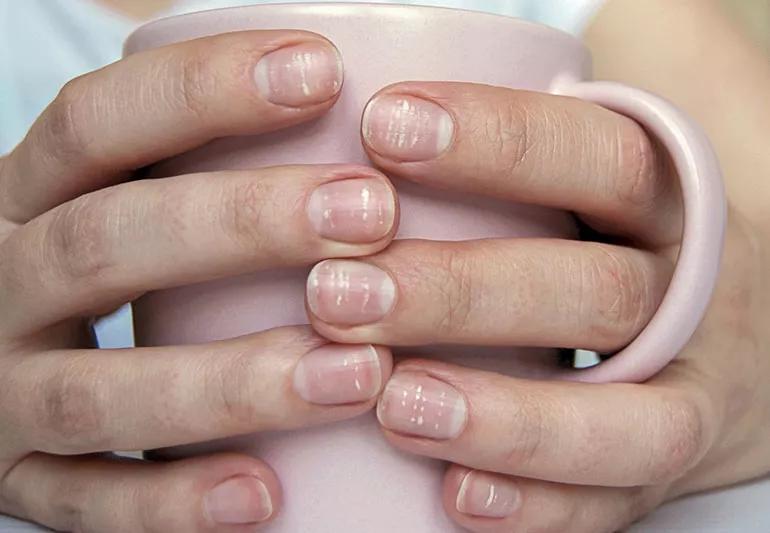These nail changes could be a sign you had COVID-19

Coronavirus can do weird things to your body, even after you’ve recovered. Some people have brain fog, and others experience hair loss or rashes. But now there’s another strange symptom to look for: “COVID nails.”
Advertisement
Cleveland Clinic is a non-profit academic medical center. Advertising on our site helps support our mission. We do not endorse non-Cleveland Clinic products or services. Policy
Dermatologist Alok Vij, MD, explains what COVID nails look like and what to do if you have them.
COVID nails are nail changes that happen a few days or weeks after a COVID-19 infection. They’re either a sign that the infection stressed your body, or they could be a rare symptom of the infection itself, depending on your symptoms. COVID nails are not an actual medical diagnosis, but they’re a possible after-effect of the disease.
If you have COVID nails, you might notice three types of nail symptoms:
Beau’s lines look like dents or ridges that run across your nails horizontally. They can happen after nail damage, like slamming your finger in a door. But they may also happen if you’ve been sick or really stressed.
Beau’s lines are a sign that your body was preoccupied and temporarily couldn’t make new nails. Instead, it directed its attention to more important things. Severe emotional stress, like a death in the family or a divorce, can also cause Beau’s lines.
“Beau’s lines can happen after any stressful event, so they’re not always a sign of COVID-19,” says Dr. Vij. “But people can get Beau’s lines after COVID-19 because their bodies had to preserve vital organ function. Making nails is much lower on the priority list when you’re extremely sick.”
Advertisement
You won’t see Beau’s lines immediately after a diagnosis, though. It takes several weeks for the damaged part of your nail to emerge from the nail bed. So once you see Beau’s lines, you’ll know that whatever caused them happened at least a month ago.
A few people have developed a red half-moon shape on their nails soon after a COVID-19 infection. The red markings appear about two weeks after a COVID-19 diagnosis. This shape shows up right above the lunula, the white part at the base of your nail.
“The half-moon nail sign is new. We haven’t seen it with other illnesses,” says Dr. Vij. “And it has only appeared in people who have a recent diagnosis. That’s why we think that it could be a pretty reliable sign of COVID-19 infection.”
So what do you do if you haven’t been diagnosed with COVID-19, but you notice this sign? Don’t panic, but call your doctor. You might need to get a test and start masking and social distancing, if you’re not already. You could have a current, contagious COVID-19 infection.
“We don’t know for sure why COVID-19 causes the red half-moon sign,” says Dr. Vij. “It could be a sign of inflammation or blood vessel damage. It could also mean that you have a higher risk of blood clots due to COVID-19. Ask your doctor if you should get any tests or treatment.”
Mees’ lines look like white lines or stripes that run horizontally across the nail. Unlike Beau’s lines, Mees’ lines are smooth. You won’t feel a dent or ridge in the nail.
“Mees’ lines can appear after COVID-19 infections,” says Dr. Vij. “They’re a sign that something interrupted your nail growth. We also see Mees’ lines with other severe illnesses and certain types of poisonings, such as arsenic.”
People with chronic conditions like kidney failure might have a series of Mees’ lines on each of their nails. But if the Mees’ lines happen after COVID-19, you’ll probably see just one white line on each nail.
If you enjoy an Instagram-worthy French manicure, you might be unhappy about COVID nails. But this symptom isn’t permanent. The red half-moon sign gradually fades on its own. Beau’s lines and Mees’ lines grow out as your nail grows, which takes about six months.
In the meantime, you can cover the imperfections with nail products. Nail ridge filler topped with nail color can camouflage Beau’s lines. You can conceal the red half-moon or Mees’ lines with some nail polish, too.
If possible, though, take a break from nail products occasionally. They can damage or weaken your nails if you use them too often. And it’s helpful to see what your real nails look like.
Advertisement
“Your nails provide a window into what’s going on inside your body,” says Dr. Vij. “People who use nail polish or artificial nails all the time don’t get to see into that window.”
COVID nails are a real thing — but they’re not a guarantee that you’ve contracted the virus or have immunity to it. So don’t forego the vaccine or precautions like masking because you have COVID nails. There’s no research to show that having this symptom will keep you safe from an infection.
Make a habit of checking out your natural nails every so often. Your nails could be trying to tell you something important about your health.
Advertisement
Learn more about our editorial process.
Advertisement

Most can return to work or school when they’re symptom-free for 24 hours

Covering your mouth when you cough and staying home when you’re sick are a couple ways to help keep yourself and others COVID-free

This vital nutrient supports your health, but its role in COVID-19 prevention and treatment isn’t proven

Studies have shown promising results, but additional research is needed

Infection and inflammation can cause you to lose your voice and have other voice changes until you’re fully healed

A COVID-19 infection can bring on depression or anxiety months after physical symptoms go away

Just like the flu, COVID-19 continues to evolve every year with new and smarter variants

The latest omicron subvariants carry specific mutations that may allow the SARS-CoV-2 virus to be better at evading immune protection

The best parenting style balances enforcing rules and showing plenty of love

Tips include cutting back on sugar, focusing on exercise and managing stress

It can be harder to let go when you’ve invested time, energy and emotions — but it might be the healthier choice long term